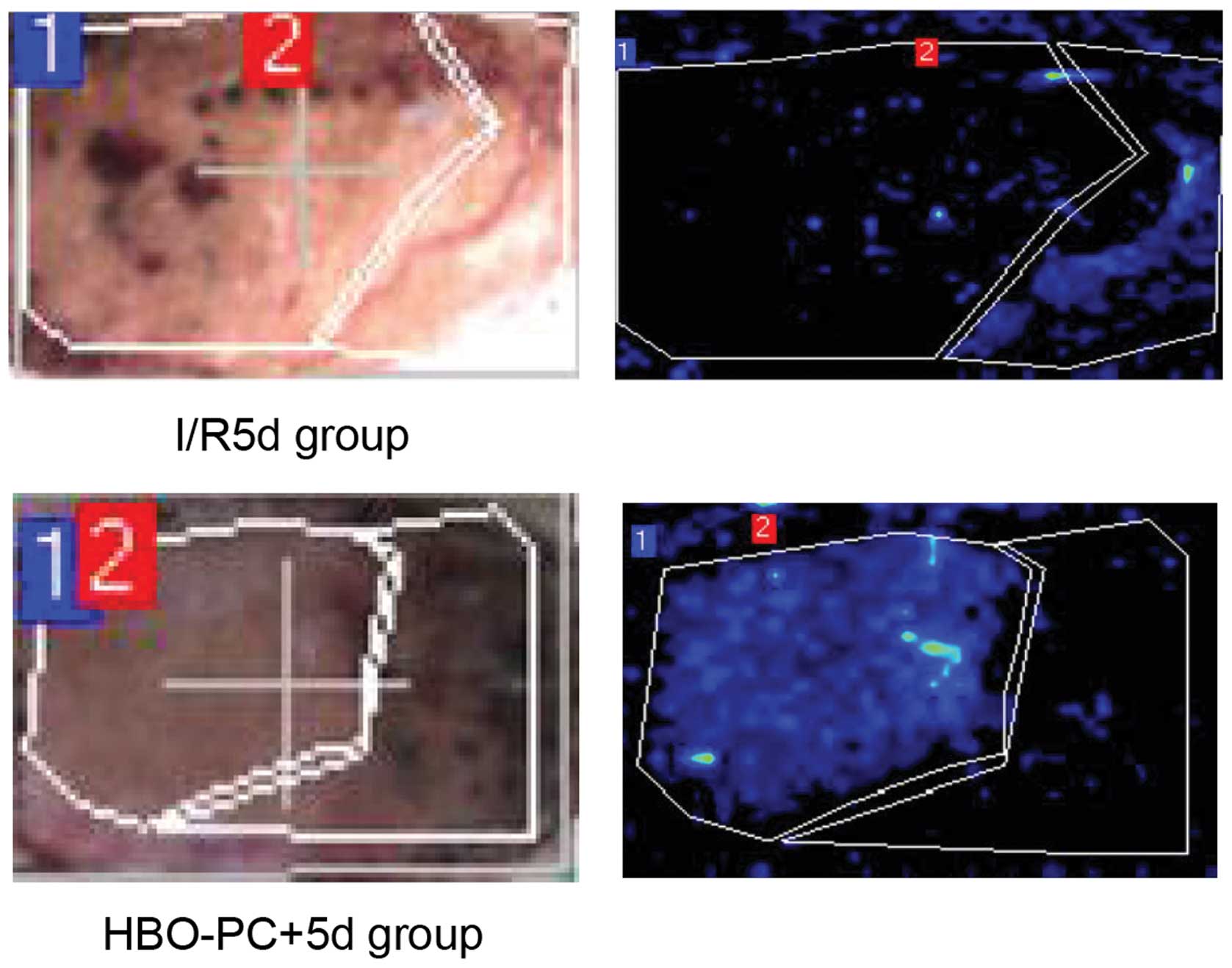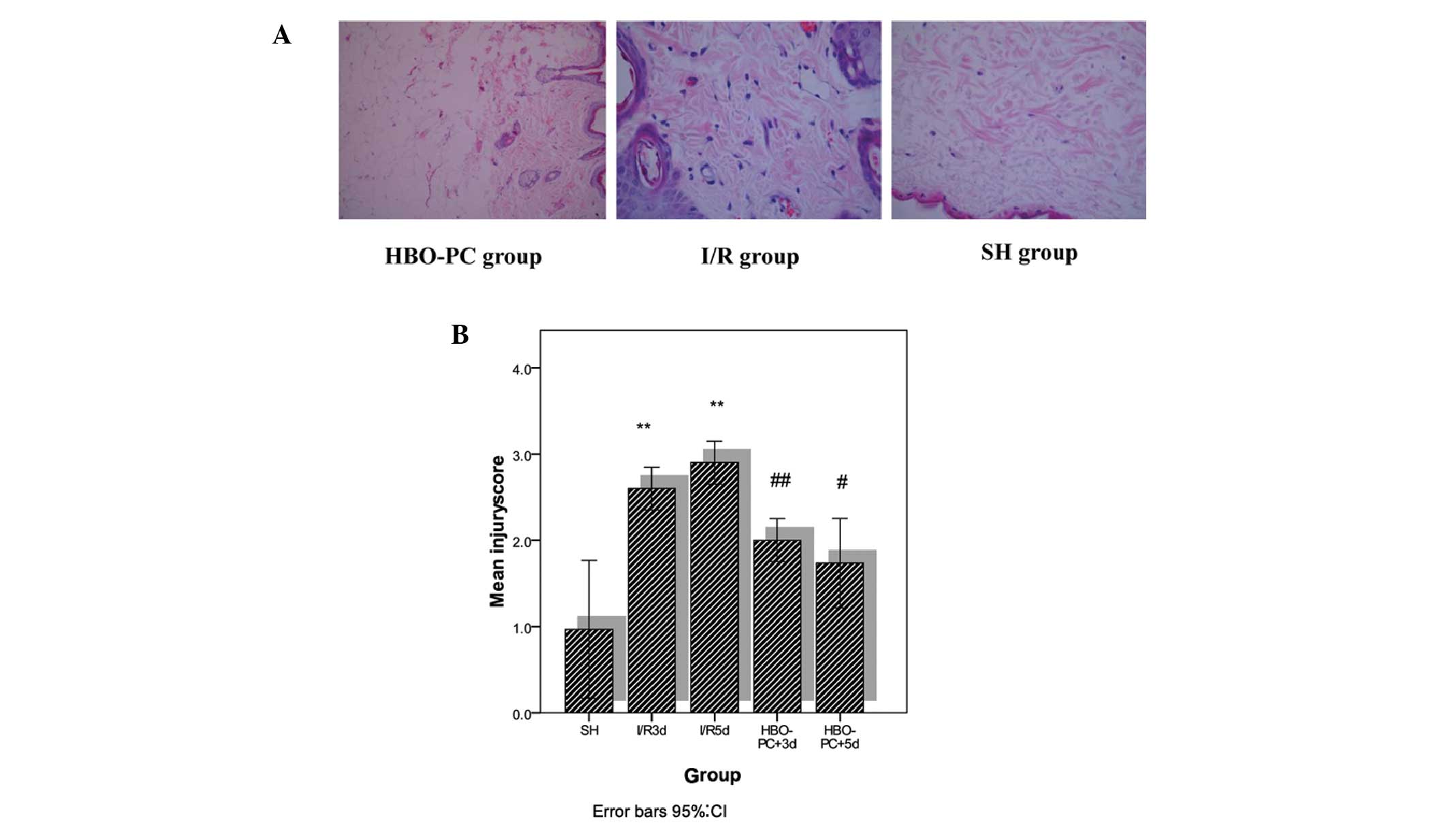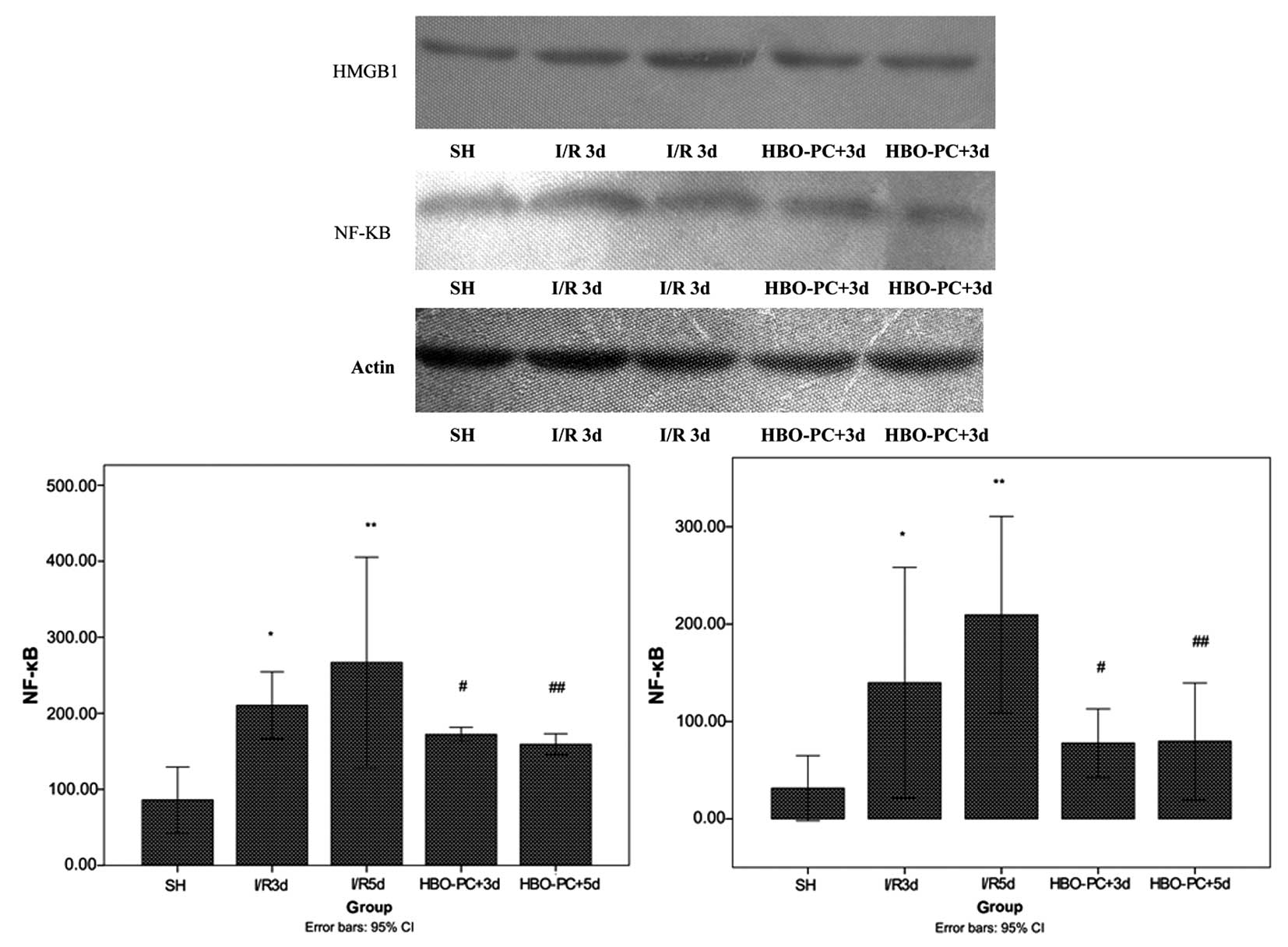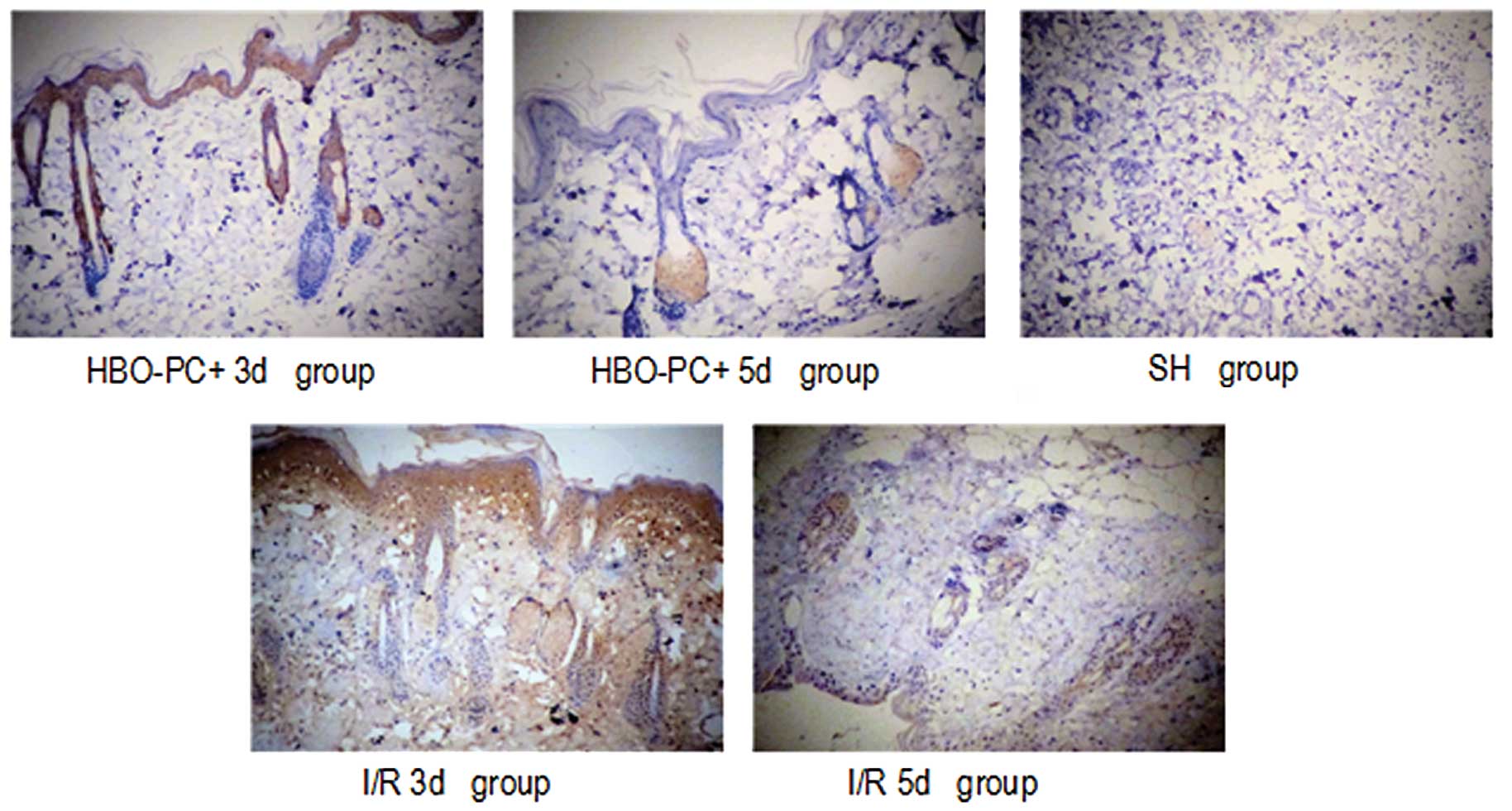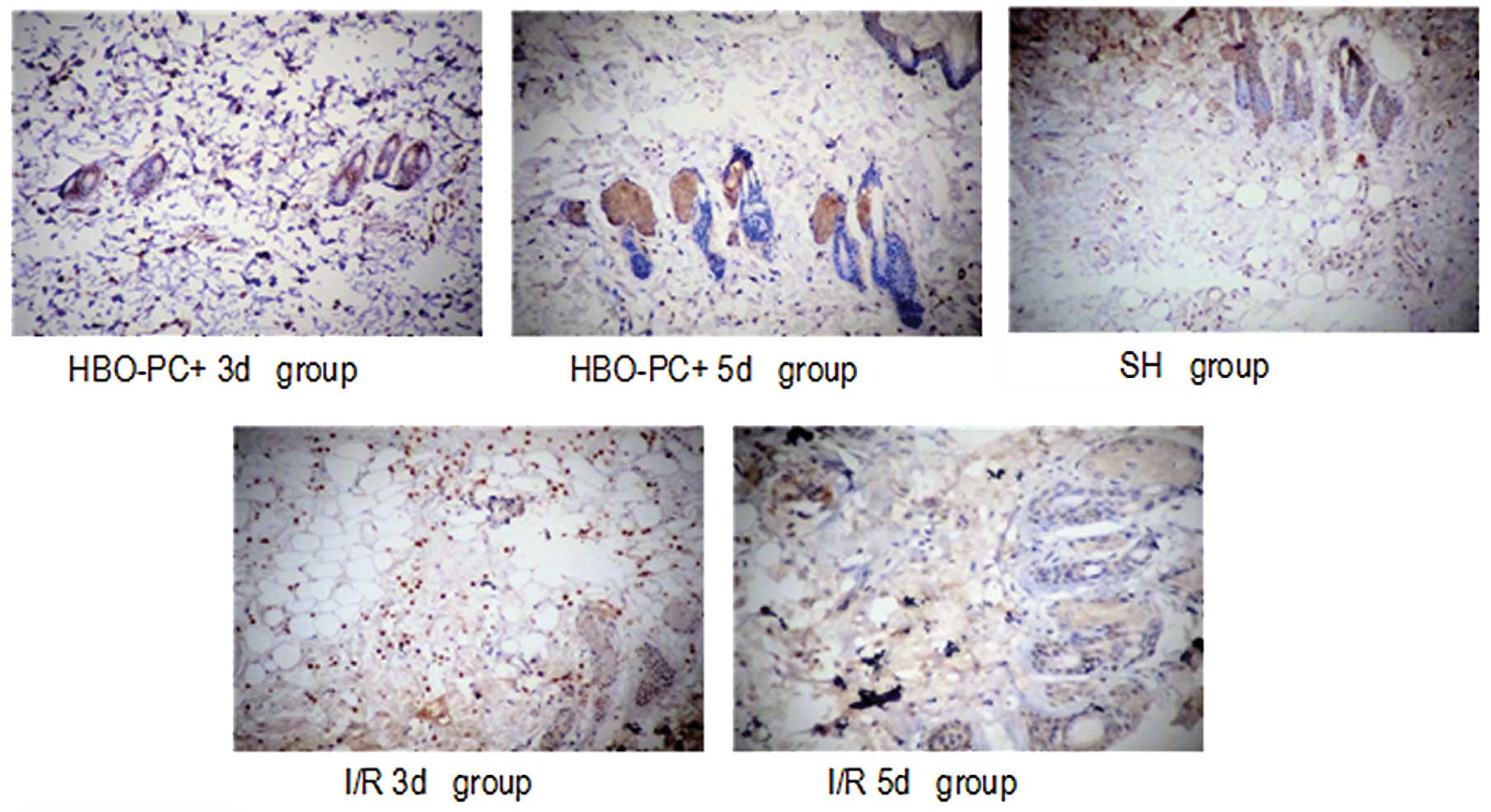|
1
|
Kerrigan CL and Stotland MA: Ischemia
reperfusion injury: a review. Microsurgery. 14:165–175. 1993.
View Article : Google Scholar : PubMed/NCBI
|
|
2
|
Siemionow M and Arslan E:
Ischemia/reperfusion injury: a review in relation to free tissue
transfers. Microsurgery. 24:468–475. 2004. View Article : Google Scholar : PubMed/NCBI
|
|
3
|
Yoshida WB and Campos EB: Ischemia and
reperfusion in skin flaps: effects of mannitol and vitamin C in
reducing necrosis area in a rat experimental model. Acta Cir Bras.
20:358–363. 2005. View Article : Google Scholar : PubMed/NCBI
|
|
4
|
Kuo YR, Wang FS, Jeng SF, Huang HC, Wei FC
and Yang KD: Nitrosoglutathione modulation of platelet activation
and nitric oxide synthase expression in promotion of flap survival
after ischemia/reperfusion injury. J Surg Res. 119:92–99. 2004.
View Article : Google Scholar
|
|
5
|
Xiong LZ, Zhu ZH, Dong HL, Hu W, Hou L and
Chen S: Hyperbaric oxygen preconditioning induces neuroprotection
against transient not permanent middle cerebral artery occlusion
rat model. Chin Med J (Engl). 113:836–839. 2000.
|
|
6
|
Dong H, Xiong L, Zhu Z, Chen S, Hou L and
Sakabe T: Preconditioning with hyperbaric oxygen and hyperoxia
induces tolerance against spinal cord ischemia in rabbits.
Anesthesiology. 96:907–912. 2002. View Article : Google Scholar : PubMed/NCBI
|
|
7
|
Wada K, Miyazawa T, Nomura N, Tsuzuki N,
Nawashiro H and Shima K: Preferential conditions for and possible
mechanisms of induction of ischemic tolerance by repeated
hyperbaric oxygenation in gerbil hippocampus. Neurosurgery.
49:160–167. 2001.PubMed/NCBI
|
|
8
|
Wang YC, Zhang S, Du TY, Wang B and Sun
XQ: Hyperbaric oxygen preconditioning reduces ischemia-reperfusion
injury by stimulating autophagy in neurocyte. Brain Res.
1323:149–151. 2010. View Article : Google Scholar : PubMed/NCBI
|
|
9
|
Yang H, Hreggvidsdottir HS, Palmblad K,
Wang H, Ochani M, Li J, et al: A critical cysteine is required for
HMGB1 binding to Toll-like receptor 4 and activation of macrophage
cytokine release. Proc Natl Acad Sci USA. 107:11942–11947. 2010.
View Article : Google Scholar : PubMed/NCBI
|
|
10
|
Pavare J, Grope I, Kalnins I and Gardovska
D: High-mobility group box-1 protein, lipopolysaccharide-binding
protein, interleukin-6 and C-reactive protein in children with
community acquired infections and bacteraemia: a prospective study.
BMC Infect Dis. 10:282010. View Article : Google Scholar
|
|
11
|
Lotze MT, Zeh HJ, Rubartelli A, Sparvero
LJ, Amoscato AA, Washburn NR, et al: The grateful dead:
damage-associated molecular pattern molecules and
reduction/oxidation regulate immunity. Immunol Rev. 220:60–81.
2007. View Article : Google Scholar : PubMed/NCBI
|
|
12
|
Li Q and Verma IM: NF-kappaB regulation in
the immune system. Nat Rev Immunol. 2:725–734. 2002. View Article : Google Scholar : PubMed/NCBI
|
|
13
|
Zdichavsky M, Jones JW, Ustuner ET, Ren X,
Edelstein J, Maldonado C, et al: Scoring of skin rejection in a
swine composite tissue allograft model. J Surg Res. 85:1–8. 1999.
View Article : Google Scholar : PubMed/NCBI
|
|
14
|
Rongione AJ, Kusske AM, Kwan K, Ashley SW,
Reber HA and McFadden DW: Interleukin 10 reduces the severity of
acute pancreatitis in rats. Gastroenterology. 112:960–967. 1997.
View Article : Google Scholar : PubMed/NCBI
|
|
15
|
Rosato E, Borghese F, Pisarri S and
Salsano F: Laser Doppler perfusion imaging is useful in the study
of Raynaud’s phenomenon and improves the capillaroscopic diagnosis.
J Rheumatol. 36:2257–2263. 2009.PubMed/NCBI
|
|
16
|
Wong HP, Zamboni WA and Stephenson LL:
Effect of hyperbaric oxygen on skeletal muscle necrosis following
primary and secondary ischemia in a rat model. Surg Forum.
47:705–707. 1996.
|
|
17
|
Elktzschig HK and Collard CD: Vascular
ischemia and reperfusion injury. Br Med Bull. 70:71–86. 2004.
View Article : Google Scholar
|
|
18
|
Aydogan H, Gurlek A, Parlakpinar H, Askar
I, Bay-Karabulut A, Aydogan N, et al: Beneficial effects of caffeic
acid phenethyl ester (CAPE) on the ischaemia-reperfusion injury in
rat skin flaps. J Plast Reconstr Aesthet Surg. 60:563–568. 2007.
View Article : Google Scholar : PubMed/NCBI
|
|
19
|
Feng GM, Yang WG, Huan-Tang CS, Chu YM,
Tsai LM, Chang TM, et al: Periodic alterations of jejunal mucosa
morphology following free microvascular transfer for
pharyngoesophageal reconstruction. J Plast Reconstr Aesthet Surg.
59:1312–1317. 2006. View Article : Google Scholar
|
|
20
|
Cetin C, Köse AA, Aral E, Colak O, Erçel
C, Karabağli Y, et al: Protective effect of fucoidin (a neutrophil
rolling inhibitor) on ischemia reperfusion injury: experimental
study in rat epigastric island flaps. Ann Plast Surg. 47:540–546.
2001. View Article : Google Scholar
|
|
21
|
Tomur A, Etlik O and Gundogan NU:
Hyperbaric oxygenation and antioxidant vitamin combination reduces
ischemia-reperfusion injury in a rat epigastric island skin-flap
model. J Basic Clin Physiol Pharmacol. 16:275–285. 2005. View Article : Google Scholar : PubMed/NCBI
|
|
22
|
Reichenberger MA, Heimer S, Schaefer A,
Lass U, Gebhard MM, Germann G, et al: Adipose derived stem cells
protect skin flaps against ischemia-reperfusion injury. Stem Cell
Rev. 8:854–862. 2012. View Article : Google Scholar : PubMed/NCBI
|
|
23
|
Kim CH, Choi H, Chun YS, Kim GT, Park JW
and Kim MS: Hyperbaric oxygenation pretreatment induces catalase
and reduces infarct size in ischemic rat myocardium. Pflugers Arch.
442:519–525. 2001. View Article : Google Scholar : PubMed/NCBI
|
|
24
|
Prass K, Wiegand F, Schumann P, Ahrens M,
Kapinya K, Harms C, et al: Hyperbaric oxygenation induced tolerance
against focal cerebral ischemia in mice is strain dependent. Brain
Res. 871:146–150. 2000. View Article : Google Scholar : PubMed/NCBI
|
|
25
|
Yamada T, Taguchi T, Hirata Y, Suita S and
Yagi H: The protective effect of hyperbaric oxygenation on the
small intestine in ischemia-reperfusion injury. J Pediatr Surg.
30:786–790. 1995. View Article : Google Scholar : PubMed/NCBI
|
|
26
|
Yu SY, Chiu JH, Yang SD, Yu HY, Hsieh CC,
Chen PJ, et al: Preconditioned hyperbaric oxygenation protects the
liver against ischemia-reperfusion injury in rats. J Surg Res.
128:28–36. 2005. View Article : Google Scholar : PubMed/NCBI
|
|
27
|
Li Y, Dong H, Chen M, Liu J, Yang L, Chen
S, et al: Preconditioning with repeated hyperbaric oxygen induces
myocardial and cerebral protection in patients undergoing coronary
artery bypass graft surgery: a prospective, randomized, controlled
clinical trial. J Cardiothorac Vasc Anesth. 25:908–916. 2011.
View Article : Google Scholar
|
|
28
|
Andrassy M, Volz HC, Igwe JC, Funke B,
Eichberger SN, Kaya Z, et al: High-mobility group box-1 in
ischemia-reperfusion injury of the heart. Circulation.
117:3216–3226. 2008. View Article : Google Scholar : PubMed/NCBI
|
|
29
|
Tsung A, Sahai R, Tanaka H, Nakao A, Fink
MP, Lotze MT, et al: The nuclear factor HMGB1 mediates hepatic
injury after murine liver ischemia-reperfusion. J Exp Med.
201:1135–1143. 2005. View Article : Google Scholar : PubMed/NCBI
|
|
30
|
Scaffidi P, Misteli T and Bianchi ME:
Release of chromatin protein HMGB1 by necrotic cells triggers
inflammation. Nature. 418:191–195. 2002. View Article : Google Scholar : PubMed/NCBI
|
|
31
|
Wang H, Bloom O, Zhang M, Vishnubhakat JM,
Ombrellino M, Che J, et al: HMG-1 as a late mediator of endotoxin
lethality in mice. Science. 285:248–251. 1999. View Article : Google Scholar : PubMed/NCBI
|
|
32
|
Andersson U, Wang H, Palmblad K, Aveberger
AC, Bloom O, Erlandsson-Harris H, et al: High mobility group 1
protein (HMG-1) stimulates proinflammatory cytokine synthesis in
human monocytes. J Exp Med. 192:565–570. 2000. View Article : Google Scholar : PubMed/NCBI
|
|
33
|
Duan XF, Huang YM, Zhou YQ, Xu JJ and
Zhang Q: Study of hyperbaric oxygenation on serum resistin and
HMGB1 in patients with severe craniocerebral injury. Chin J
Clinicians. 5:3189–3192. 2011.
|
|
34
|
Chen YQ, Liu DH, Yang GT, et al:
Expression of nuclear factor kappa B in rats after acute global
cerebral ischemia-reperfusion and its significance. J Clin Res.
121:772–774. 2004.
|
|
35
|
Qin C, Xiao YB, Zhong QJ, Chen L and Wang
XF: Anti-inflammatory effect of erythropoietin pretreatment on
cardiomyocytes with hypoxia/reoxygenation injury and the possible
mechanism. Chin J Traumatol. 11:352–358. 2008.PubMed/NCBI
|
|
36
|
Ghosh S and Baltimore D: Activation in
vitro of NF-kappa B by phosphorylation of its inhibitor I kappa B.
Nature. 344:678–682. 1990. View
Article : Google Scholar : PubMed/NCBI
|
|
37
|
Wang L, Zhang X, Liu L, Cui L, Yang R, Li
M, et al: Tanshinone II A down-regulates HMGB1, RAGE, TLR4,
NF-kappaB expression, ameliorates BBB permeability and endothelial
cell function, and protects rat brains against focal ischemia.
Brain Res. 1321:143–151. 2010. View Article : Google Scholar : PubMed/NCBI
|
|
38
|
Yang J, Li Y and Hu C: Ischemic
preconditioning protects against myocardial ischemia-reperfusion
injury through inhibiting toll-like receptor 4/NF-κB signaling
pathway in rats. Zhong Nan Da Xue Xue Bao Yi Xue Ban. 36:972–978.
2011.PubMed/NCBI
|



